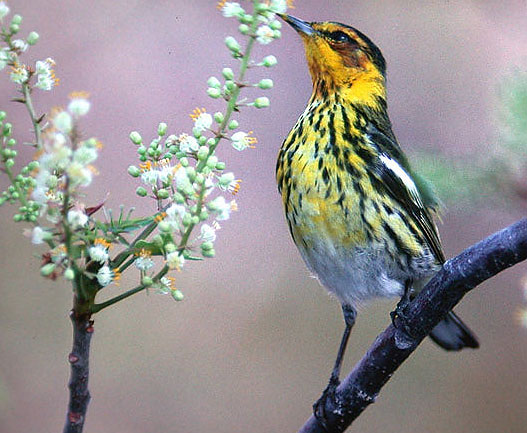- Dendroica tigrina
Description
The Cape May Warbler is a small New World warbler. It breeds in northern North America across all but the westernmost parts of southern Canada, and into the Great Lakes region and New England. It is migratory, wintering in the West Indies. This species is a very rare vagrant to western Europe.
The summer male Cape May Warbler has a brown back, yellowish rump and dark brown crown. The underparts are yellow, streaked black, giving rise to the bird's scientific name. The throat and nape are bright yellow and the face is chestnut with a black eyestripe. There is a narrow white wing bar.
Other plumages are washed-out versions of the summer male, and in particular lack the strong head pattern. The yellowish rump and at least indications of the white wing bar are always present.
Bill sharply pointed. Male: Face and sides of neck yellow with chestnut auricular patch. Throat and underparts yellow becoming white on vent and undertail coverts, heavily streaked black on lower throat, chest, and flanks. Crown, nape, and upperparts olive with black centers, yellowish rump. Wings and tail blackish, edged olive, with whiteish wing panel and white tail-spots.
These birds are insectivorous, and lay larger clutches in years when Spruce Budworm is abundant. They pick insects from the tips of conifer branches or fly out to catch insects in flight. They also feed on berry juice and nectar in winter, and have, uniquely for a warbler, a tubular tongue to facilitate this.
Range & Habitat
Breeds in Northeast North America and winters Caribbean and adjacent coasts of Middle America.
The breeding habitat is the edges of coniferous woodland, especially Black Spruce.
Nesting
Cape May Warblers nest in dense foliage near the trunk of a conifer, laying 4-9 eggs in a cup nest.
Voice
Song very high and thin; may sound slightly buzzy; four to seven unslurred notes (5/second) seet seet seet seet seet or slightly lower-pitched, faster, more complex seeo seeo seeo seeo seeo or witse witse witse wit Call a very high hard, short te. Flight call a very high, slightly buzzy tzew or tzee slightly descending.
The song is a simple repetition of high tsi notes. This bird usually sings from high perches. The call is a thin sip.




